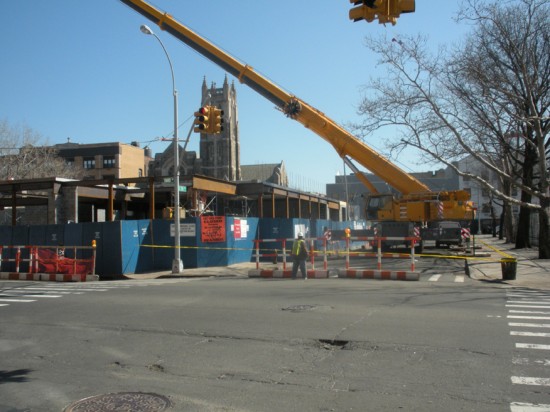
Contaminated vacant lots are cleaned up
An eight-story apartment building rising on the Northeast corner of East 158th Street and Third Avenue will complete the transformation of the intersection.
Dubbed La Terraza, the building will join two more apartment buildings developed by the Melrose-based non-profit Nos Quedamos in the last decade.
Offering 107 apartments for middle, moderate, and low-income families, along with new stores, La Terraza will occupy one of the last vacant lots in the Melrose Commons urban renewal area. Spills of chemicals from a drycleaner that once occupied part of the site had to be cleaned up before construction could begin.
Two more buildings are rising on another formerly contaminated site, on Courtlandt Avenue between East 160th and 161st streets. There, a gas station had polluted the ground.
Called “brownfields,” underutilized and often contaminated sites like these are found throughout urban areas, but are especially numerous in neighborhoods like Mott Haven, Melrose and Hunts Point where crime, poverty and a changing economy have led many businesses to close and many building owners to abandon their property.
“In a place like NYC where land is scarce, we need to develop our brownfields,” said Shira Gidding, the director of environmental planning and development at the South Bronx Overall Development Corporation (SoBRO), which has applied to the state for aid in redeveloping brownfields in Port Morris.
A number of state and city programs aim to encourage developers by offering financial incentives to clean up and rebuild on contaminated sites. La Terazza, which is being developed through the New York City Department of Housing Preservation and Development’s Cornerstone program, is one of 14 Bronx projects that have benefited from the state Brownfield Cleanup Program.
The program was once criticized for favoring mega-projects and excluding non-profits seeking to develop small lots. “Big developers were getting into the program and building hotels and luxury apartments that did not serve an impoverished community,” Gidding said.
The Legislature rewrote the law in 2008, making funds available to community development organizations like Nos Quedamos and Phipps Houses, the developer of the Courtland Avenue site.
Nevertheless, some are skeptical of the claim that these buildings will be affordable. Elliott Liu, 27, works at the South Bronx Food Co-Op across the street La Terraza, and has lived in the neighborhood for three years.
“I guess I’m a skeptic because affordable housing means different things to different people,” Liu said. A graduate of Sarah Lawrence College, who works part-time at the food co-op and builds computers and designs websites as a hobby, Liu said that he probably could not afford to live in the new building on his $8,000-a-year salary.
He said he hears more about other affordable housing developments in the area, like Boricua Village, but he said that the residents that he encounters have mixed feelings, too. He said some people say, “Oh, that sounds so awesome,” others fear the rents of newer buildings will be out of reach.
But Yolanda Gonzalez, the executive director of Nos Quedamos, says 10 percent of the apartments in La Terraza are reserved for homeless families and half the tenants, to be chosen by lottery, will be people who currently live in the neighborhood.
The new buildings have certainly attracted notice, said Roberto Rodriguez, a security worker who monitors the site on Courtlandt Avenue. “People must like” the look of the building, he said, “because a woman just asked me about an application.” The complex, which will include two buildings rising to 10 stories, will offer 320 low-income apartments when it is completed this fall.
Phipps Houses spent $7.6 million to clean it up the site. It will get its investment back by selling tax credits from the Brownfield Cleanup Program equal to the total cost of the development.
Gonzalez, whose organization has been involved in the development of La Casa de Felicidad, La Puerta de Vitalidad, La Terraza and other properties within the Melrose Commons area, contends that the new construction is vital to reestablish a once-vibrant part of the Bronx.
She describes the new housing as a community effort, and said that where land is at a premium, “We need housing for everyone, not just a few.”
A version of the story appeared in the April 2010 issue of the Mott Haven Herald.
